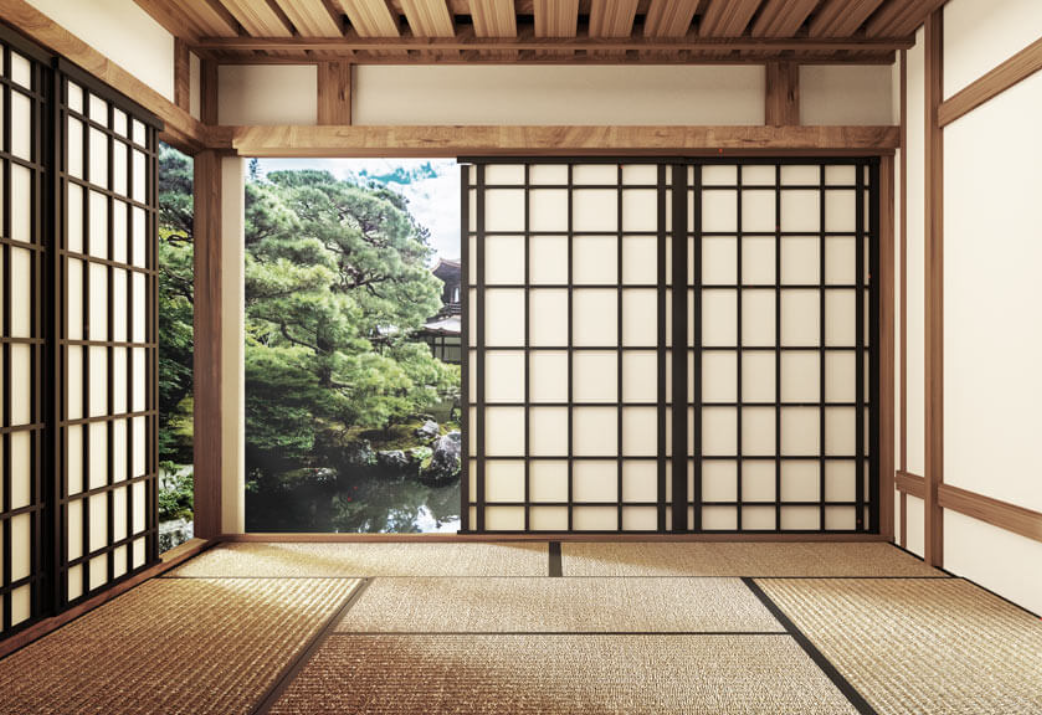Secrets of Tatami Mats 畳
Tatami mats are a traditional flooring unique to Japan. Made with woven straw, these mats are a key element of traditional Japanese architecture. While today, modern houses use a range of flooring types, many homes still have at least one tatami room or area. Growing up, my house had a tatami living room and a tatami family room. The room to welcome a guest had a wooden floor with a set of 2 rattan chairs and a little table, and my piano. So I basically grew up sitting on tatami mats. Now they have a new house with a sofa set. But they still sit on the rug in front of the sofa, leaning back to the sofa! Whether at a temple, restaurant or inn, you will most likely encounter some tatami mat rooms in Japan. Today I would like to focus on tatami edges.
The history of tatami hems is known to have started with tatami mats. In the Todaiji Kenmotu Cho (a list of dedicated articles to the Todaiji Temple), “black brocaded” tatami hems were listed as part of dedicated items. This indicates the tatami hem application was already diversified using available materials in the Nara Period (710s), which can be seen on the royal floor mat for Emperor Shomu (730s), one of collections at the Shosoin Treasure House in Nara Prefecture. A tatami mat started to develop as a single layer of tatami surface with the hems before turning into today’s form attached with a thick mattress base.
In the Heian period (794 -1185), aristocratic mansions adopted a symmetrical architecture style (Shinden-zukuri). The tatami mats were partially placed as beds on the wooden floor of the rooms. The usage of the tatami bedding and hems were regulated depending on the social rankings of the residents.
In Kyoto Imperial Palace, knows as a historical Shinzen Sukari architecture, tatami hems with “Ungen Beri” design was used. The textile was originated from “Ungen Nishiki”, which brought from teh Korean Peninsula. It is a rainbow colored striped design that uses chrysanthemum’s and clouds as seen on the edges of tatami mats under the imperial Hina Dolls.
In the Muromachi Period (1336 - 1573), development of a prototype of Japanese residencial architecture (Shoin Zukuri) was completed. The tatami mats were commonly placed covering entire floors in the room.
Enough of the history lesson, now let’s talk about ‘manners’. Besides from wearing a clean pair of socks to wear on tatami mats that I mentioned on the blog ‘5 Things Not to Do in Japan’ https://www.yokobeverlyhills.com/blog/5-things-not-to-do-in-japan , you walk with 6 steps to cross a tatami mat, then cross over the tatami edge. Not stepping on tatami edge is the most imporant manner. Here are the reason why.
1. Some tatami edges are luxurious using gold and silver thread, and even have their kamon crests woven. (see the blog about Kamon Crest here. https://www.yokobeverlyhills.com/blog/kamon-crest You cannot step on symbol of someone’s family name. The edge means borderline between class / level of the people as well.
2. Some are natural dyed with plants. It is to avoid getting faded or damaged.
3. Edge parts are a little higher than the straw parts, therefore simply to avoid tripping.
4. This is the most interesting reason for you. If a ninja is hiding underneath, they would stick their sword upwards through the edges. You need to avoid an injury. :)
5. If you don’t have a washi paper to put your sweet on during a tea ceremony, you put the sweet on the edge. Nobody steps on it, and they would clean the room before the guest comes, so edges are supposed to be clean, but this is most unlikely in my opinion as I don’t think the host would forget to give you the washi paper as a plate.
These days tatami edges are also repurposed to make varieties of things, and even trendy, such as tableware, wreath, bags, hair accesaries or bonett hats, corsage, and business card holders, etc etc. Yoko Beverly Hills now offers authentic high end tatami edges from a long established tatami making company (over 100 years old), in a region named Kurashiki, Okayama known for tatami making culture and history. Tatami edges in my childhood home was green, nothing special, the edges I sourced are so colorful and beautiful, I had to double check of its authenticity. I suppose they are either a new thing, or my parents never paid extra for tatami edges. Check out here for ornate ribbons; Tatami Edges. https://www.yokobeverlyhills.com/shop/tatami-ribbons


